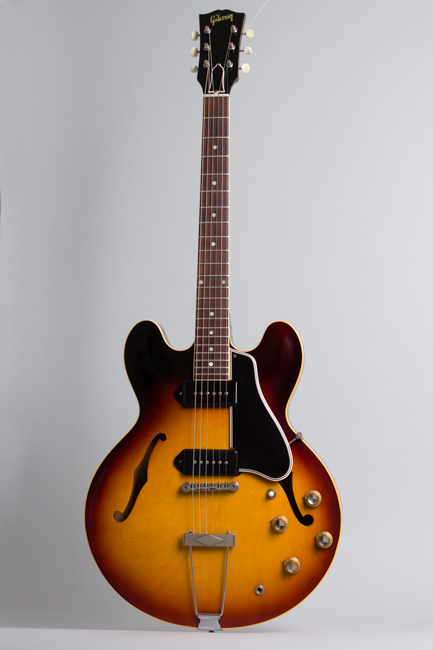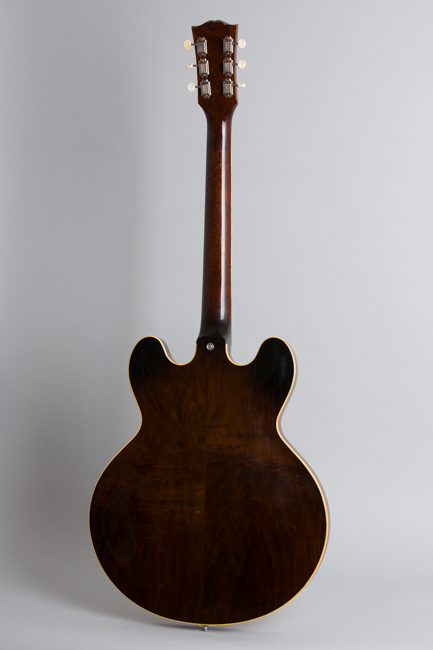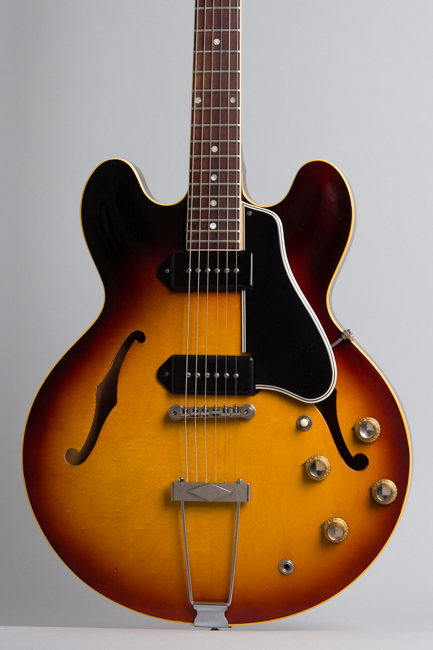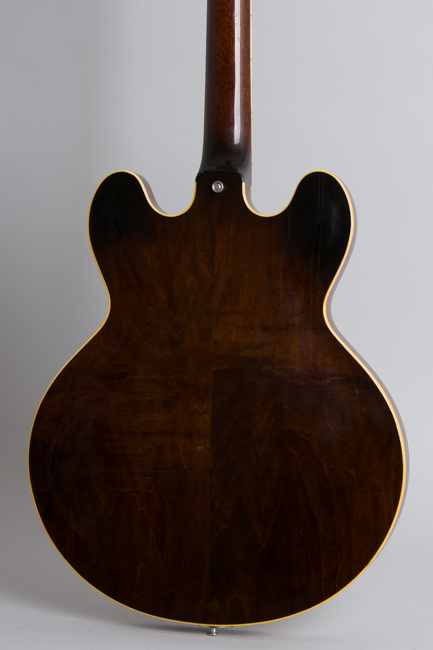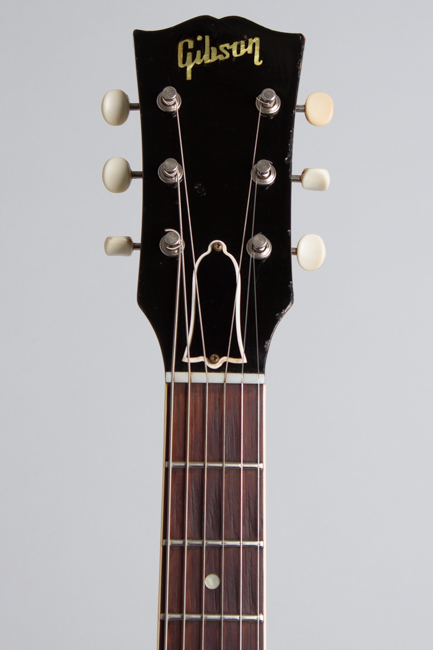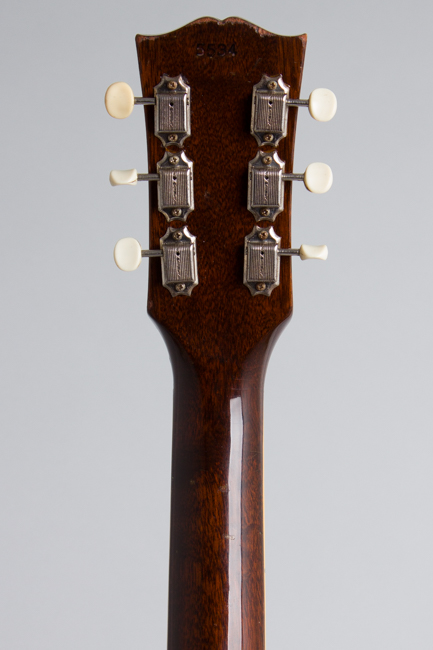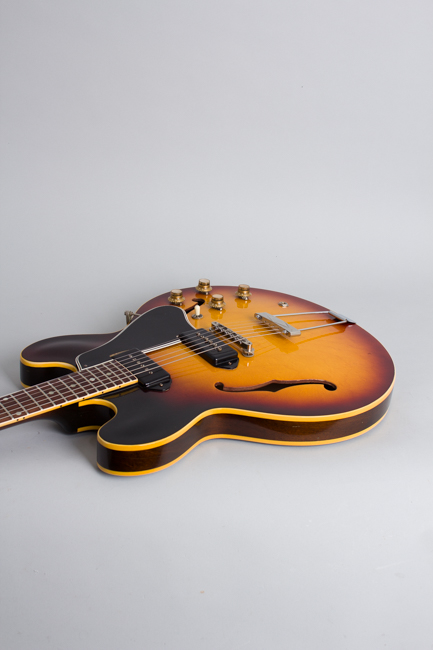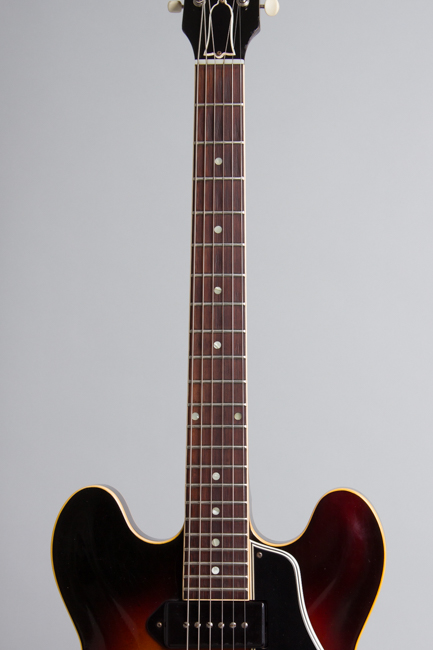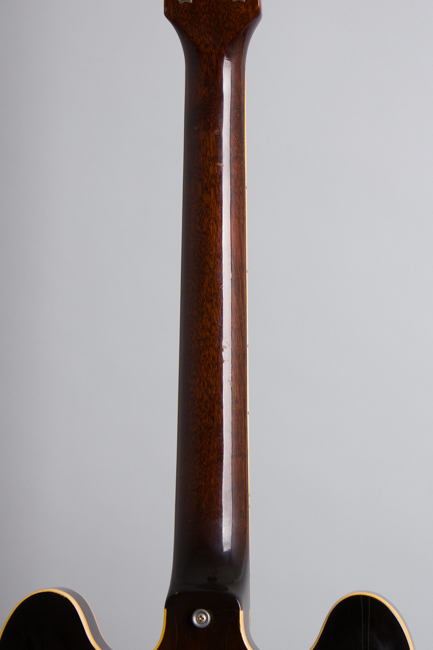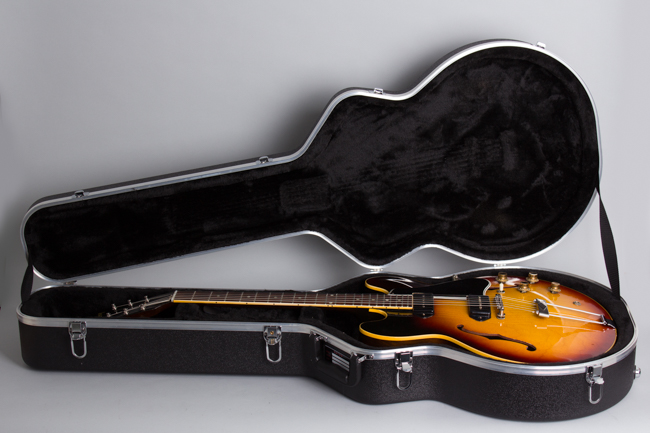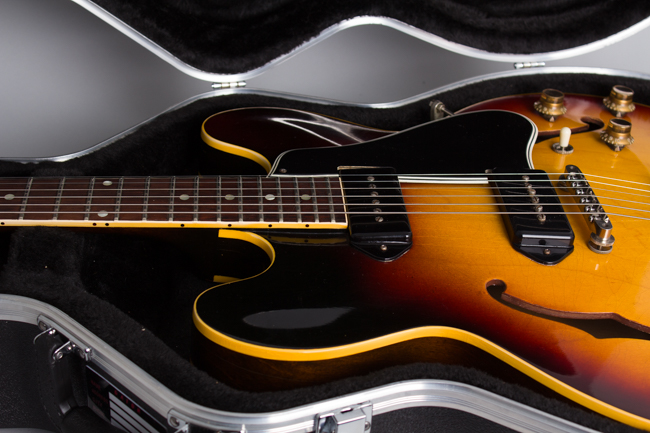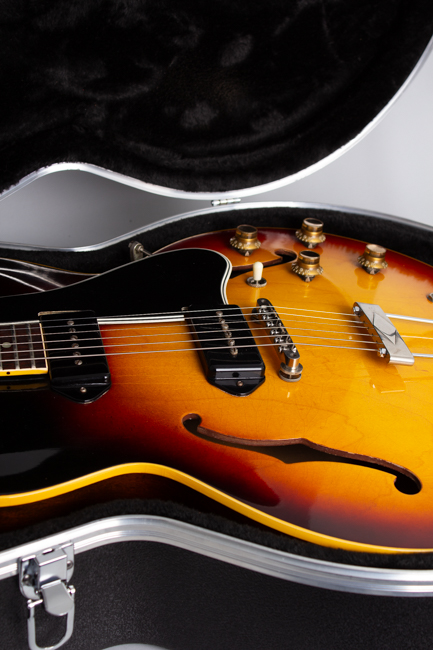Gibson ES-330TD Thinline Hollow Body Electric Guitar (1961)
This item has been sold.
Item # 11786
Prices subject to change without notice.
Gibson ES-330TD Model Thinline Hollow Body Electric Guitar (1961), made in Kalamazoo, Michigan, serial # 5534, sunburst top, dark back and sides finish, laminated maple body, mahogany neck, rosewood fingerboard, molded plastic hard shell case.
This is a nice example of a first-generation sunburst ES-330TD from early 1961, the model's second full production year. It retains all the earliest features including a bound dot-inlaid rosewood fingerboard, rounder "Mickey Mouse" cutaway horns and black plastic P-90 pickup covers. The dark shaded sunburst still has a 1950s look to it, and the serial number impressed on the back of the headstock runs to only 4 digits, from the first few months this system was in use.
The ES-330T And ES-330TD debuted in late 1959 as lower-budget additions to the ES-335 line launched the year before. The initial announcement in the October/November '59 GIBSON GAZETTE described them as "Thrilling modern instruments...Double cutaway body and thin silhouette make it wonderfully east to hold and play". The single pickup 330T only lasted into the early 1960s, but the more versatile double pickup "TD" prospered.
In 1961 only 542 of these sunburst, two pickup 330s were shipped out of Kalamazoo priced at $250 (plus case). This was less than half the previous years shipments, but the drop was mostly due to the advent of a new cherry-finish option, which quickly became the more popular version. The ES-330 was in any case regarded as a very successful model as it would remain for much of the 1960s.
This 1961 ES-330TD has a classic set of mid-line Gibson features, but a distinctive feel. While grouped with the thin-line semi-solid 335 range this is actually a very different instrument to play. The slim single-bound body is fully hollow without any center block, making it much lighter and more resonant. This also led to another distinguishing feature of the 330, the neck joining the body farther in at the 16th fret to allow the joint to be stronger.
The neck profile on this guitar is the slim, flatter 1960 style, a feature specific to this period. This one has a rounder back with a shade more "meat" to it than some 1960s. The headstock has just a pearl Gibson logo, the tuners are single-unit enclosed Kluson deluxe with plastic buttons. The two P-90 pickups are mounted under black plastic dog-ear covers, which would be replaced with metal the next year. They are controlled by the standard Gibson 4-knob one switch wiring rig, with the then-new metal-capped plastic bonnet knobs.
Despite being intended as "amateur" instruments early ES-330TDs are great-sounding, extremely versatile guitars that have been heard live and on record in many styles of music. Jazz great Grant Green used this model extensively on his most well-regarded early 1960s recordings, while Slim Harpo relied on one for his deep swamp blues. The ES-330 and its nearly identical sister the Epiphone Casino were featured by countless '60s British invasion bands, including the Beatles, Rolling Stones, Kinks, Manfred Mann, and many more. Now, as then this is a very light and handy guitar with a killer feel and sound.
Overall length is 39 3/4 in. (101 cm.), 16 in. (40.6 cm.) wide at lower bout, and 1 3/4 in. (4.4 cm.) in depth, measured at side of rim. Scale length is 24 3/4 in. (629 mm.). Width of nut is 1 11/16 in. (43 mm.).
Overall this is a very clean and nicely original guitar, showing light wear for its 60+ years on the planet with a couple of minor hardware changes. The original finish is very clean with virtually no fade and only some minimal checking. Overall there is some light scuffing and small dings and dents, most notably to the headstock edges. The back has a few very small spots of touch up, not as neatly done as it could have been but not overly conspicuous. The back of the neck has some minor dings and dents into but not through the finish.
Overall the guitar remains nicely original, including the black-covered P-90 pickups, wiring, knobs, switch, pickguard and tuners. Hardware alterations are a more modern high-grade Callaham nickel-plated Tune-O-Matic bridge substituted for the original, and the tailpiece is a hybrid of the original nickel crossbar and a later '60s chrome plated baseplate and fork. For some reason the baseplates on 330's are prone to tearing, and it looks like this combination was done a long time back, A period Gibson metal strap button was added at the heel, which is almost ubiquitous on 330's.
The original frets remain in excellent shape with some fairly light wear in the lower positions. This is a simply superb playing and sounding guitar, very light and super comfortable. It is equipped with a recent molded plastic HSC, the original case was likely chipboard and apparently long gone. Overall Excellent Condition.
This is a nice example of a first-generation sunburst ES-330TD from early 1961, the model's second full production year. It retains all the earliest features including a bound dot-inlaid rosewood fingerboard, rounder "Mickey Mouse" cutaway horns and black plastic P-90 pickup covers. The dark shaded sunburst still has a 1950s look to it, and the serial number impressed on the back of the headstock runs to only 4 digits, from the first few months this system was in use.
The ES-330T And ES-330TD debuted in late 1959 as lower-budget additions to the ES-335 line launched the year before. The initial announcement in the October/November '59 GIBSON GAZETTE described them as "Thrilling modern instruments...Double cutaway body and thin silhouette make it wonderfully east to hold and play". The single pickup 330T only lasted into the early 1960s, but the more versatile double pickup "TD" prospered.
In 1961 only 542 of these sunburst, two pickup 330s were shipped out of Kalamazoo priced at $250 (plus case). This was less than half the previous years shipments, but the drop was mostly due to the advent of a new cherry-finish option, which quickly became the more popular version. The ES-330 was in any case regarded as a very successful model as it would remain for much of the 1960s.
This 1961 ES-330TD has a classic set of mid-line Gibson features, but a distinctive feel. While grouped with the thin-line semi-solid 335 range this is actually a very different instrument to play. The slim single-bound body is fully hollow without any center block, making it much lighter and more resonant. This also led to another distinguishing feature of the 330, the neck joining the body farther in at the 16th fret to allow the joint to be stronger.
The neck profile on this guitar is the slim, flatter 1960 style, a feature specific to this period. This one has a rounder back with a shade more "meat" to it than some 1960s. The headstock has just a pearl Gibson logo, the tuners are single-unit enclosed Kluson deluxe with plastic buttons. The two P-90 pickups are mounted under black plastic dog-ear covers, which would be replaced with metal the next year. They are controlled by the standard Gibson 4-knob one switch wiring rig, with the then-new metal-capped plastic bonnet knobs.
Despite being intended as "amateur" instruments early ES-330TDs are great-sounding, extremely versatile guitars that have been heard live and on record in many styles of music. Jazz great Grant Green used this model extensively on his most well-regarded early 1960s recordings, while Slim Harpo relied on one for his deep swamp blues. The ES-330 and its nearly identical sister the Epiphone Casino were featured by countless '60s British invasion bands, including the Beatles, Rolling Stones, Kinks, Manfred Mann, and many more. Now, as then this is a very light and handy guitar with a killer feel and sound.
Overall length is 39 3/4 in. (101 cm.), 16 in. (40.6 cm.) wide at lower bout, and 1 3/4 in. (4.4 cm.) in depth, measured at side of rim. Scale length is 24 3/4 in. (629 mm.). Width of nut is 1 11/16 in. (43 mm.).
Overall this is a very clean and nicely original guitar, showing light wear for its 60+ years on the planet with a couple of minor hardware changes. The original finish is very clean with virtually no fade and only some minimal checking. Overall there is some light scuffing and small dings and dents, most notably to the headstock edges. The back has a few very small spots of touch up, not as neatly done as it could have been but not overly conspicuous. The back of the neck has some minor dings and dents into but not through the finish.
Overall the guitar remains nicely original, including the black-covered P-90 pickups, wiring, knobs, switch, pickguard and tuners. Hardware alterations are a more modern high-grade Callaham nickel-plated Tune-O-Matic bridge substituted for the original, and the tailpiece is a hybrid of the original nickel crossbar and a later '60s chrome plated baseplate and fork. For some reason the baseplates on 330's are prone to tearing, and it looks like this combination was done a long time back, A period Gibson metal strap button was added at the heel, which is almost ubiquitous on 330's.
The original frets remain in excellent shape with some fairly light wear in the lower positions. This is a simply superb playing and sounding guitar, very light and super comfortable. It is equipped with a recent molded plastic HSC, the original case was likely chipboard and apparently long gone. Overall Excellent Condition.
